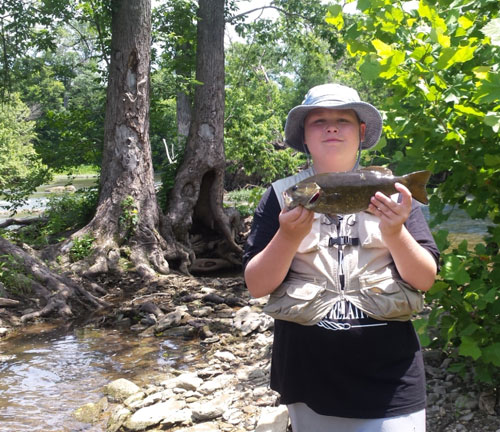BY Kevin Kelly
If free fishing weekend was a homerun with your kiddos, you might be wondering about how to keep the momentum going throughout the summer.

Take a cue from them: keep it fun.
Does this mean they need to catch a fish or get a bite every cast? Not necessarily. Fun can be wading a creek or floating down one for the first time in a canoe or kayak. Fun can be seeing how many different species of fish you can catch or how many fishing holes you can visit this summer. Fun can be catching your own live bait then using it to catch dinner.
Fun does not have to be complicated, but finding the time can be for grown-ups.
A memorable fishing trip does not require an entire day. Take off after work with your new fishing buddy and fish until dusk, or rise early and fish until mid-morning.
You probably have an idea about where to go, but lay out the options and let your young angler make the final decision. They will appreciate being involved in the process.
“Offer your suggestions but don’t be too pushy,” said Easton Copley, aquatic education program coordinator with the Kentucky Department of Fish and Wildlife Resources.
Farm ponds and Fishing in Neighborhoods (FINs) lakes are excellent options. The odds of catching fish consistently can be better in these smaller bodies of water.
The FINs program includes 43 locations across Kentucky and each is stocked throughout the year. Hybrid sunfish have been stocked in almost two dozen FINs lakes in recent days. Channel catfish were stocked in many last month.
Streams are another good option.
“In the creek, you’re always moving,” said Mike Hardin, assistant Fisheries Division director for Kentucky Fish and Wildlife. “There’s always something new around the bend. If you’re in the shallows, you’re seeing minnows. If you’re up in the shoal, you’ll see crawdads. As you wade, you can see fish dart by. You can catch a lot of fish. They can always take a friend and all of you can just go to the creek and they find their own fun.”
Kids love to play in the dirt and splash in the water. Teach them about how easy and fun it can be to do both by catching their own live bait.
Worms appeal to just about every game fish species and it’s a fairly easy activity for a young angler to collect plenty for a day trip. Observe a driveway or sidewalk after a rain shower. Along with gardens, compost piles and areas where the soil stays moist and cool, these spots can yield a bonanza of live bait.
Like worms, crayfish make great live bait, especially in waters holding smallmouth bass.
“If you’re going to look for crawdads in a large creek, look for backwater areas or areas with isolated, ponded water that’s not really flowing,” Hardin said. “You can flip rocks over there and the crayfish are easier to catch.”
Don’t forget about the pincers. Pick up a crayfish on either side of its midsection – behind the head and pincers – with your thumb and index finger. Crayfish are hearty and do fine kept in a small bait bucket filled with water. Hook them through the underside of the tail with an Octopus hook and fish them weightless or with a pinch weight.
“When you cast them in swift water, they swim a little bit and you can feel them thump. When you feel that thump, smallmouth just come to it,” Hardin said. “When there’s no more thump, and you feel that steady pull on it, you’ve got one.”
A good starter set-up for a young angler is simple – a spincast reel spooled with 4-pound clear monofilament line threaded through the guides of a 5-foot or shorter rod. Thread a worm onto an Aberdeen hook, apply a small splitshot to the line beneath a bobber and they’re ready to catch fish.
Once they’ve got a handle on how to operate the basic setup, they may want to try different equipment or presentations.
Few things in fishing are more exciting than watching a fish crash a topwater lure. To assemble an easy and productive summertime topwater presentation for panfish and bass, thread the line through a clear casting bobber and attach a small swivel to the main line. To the swivel, tie a 12- to 18-inch monofilament leader. Tie a foam spider or popper fly to the other end.
You will not want to forget your young angler’s experiences and development, so consider keeping a summer scrapbook or get them in the habit of documenting their fishing adventures in a journal. These will become treasured keepsakes for years to come and imagine how impressed their teachers will be when the new school year starts.
Note the date and location of each outing. Include photographs of fish caught and a description of the trip. Keep a log of how many species of fish were caught by your young angler over the summer.
“A sticker chart would be cool, too,” Copley said.
Measure and photograph the biggest fish. They may qualify your angler for Kentucky Fish and Wildlife’s trophy fish program. Anglers who catch a qualifying fish by pole or line can receive a trophy fish pin. Learn more about the program on the department’s website at fw.ky.gov.
Author Kevin Kelly is a staff writer for Kentucky Afield magazine, the official publication of the Kentucky Department of Fish and Wildlife Resources. Get the latest from Kevin and the entire Kentucky Afield staff by following them on Twitter: @kyafield.


Be the first to comment